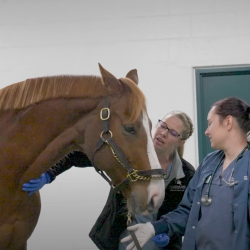Featuring Leanne Magestro, Cameron Henke, N. Bari Olivier, Hayley Gallaher, Bharadhwaj Ranganathan

History and Presentation
Annie is a 9.5-year-old female spayed Labrador mix who was presented to Michigan State University Emergency and Critical Care Medicine Service for lethargy and possible gastrointestinal obstruction. The day prior to presentation, Annie’s owner noted she was fine in the morning and became unusually quiet in the early afternoon. The owner noted that instead of being energetic on her walk, Annie stayed behind her owner, which is unusual for her. The owner woke up in the middle of the night that following night to Annie vomiting. Her owner mentioned it was black and looked like diarrhea. Annie continued to vomit three more times for the next three hours. A few hours later, Annie’s owner took her to her water dish, where she drank a large volume and subsequently vomited the water up. The owner then called his primary veterinarian and received a voice message to call a veterinary emergency line, which then led him to call MSU.
On presentation, Annie was dull weak not wanting to walk. She had muffled heart sounds as well as increased respiratory effort. Her mucous membranes were light pink, and tacky with a CRT 2 seconds, femoral pulses were weak and exhibited pulses-paradoxus, and her skin had increased turgor consistent with dehydration. Throughout the presenting examination, Annie was actively worsening; pericardial effusion was present on point-of-care TFAST ultrasound and AFAST was negative; one-hundred milliliters of hemorrhagic fluid (peripheral PCV 60%, effusion PCV 33%) was emergently removed via right-sided pericardiocentesis using a 16g angiocath and closed collection system. Unfortunately, a large mass on the right side of her heart was visible on the focal ultrasound. Within the first hour, Annie began to have recurrent clinical signs of tamponade which was confirmed with serial FASTscans. The decision was then made to place an indwelling pericardial catheter to allow for the continuation of fluid removal reducing the risk of infection and further trauma. She was placed on a lidocaine CRI for recurrent ventricular tachycardia with rates of 180-200 bpm. Once stable, Annie was hospitalized for further diagnostics and treatment.

Diagnosis
A CT scan revealed a large mass on the right side of Annie’s heart, an infarcted spleen, a single liver and several small (mm) muscle nodules.
An abbreviated interpretation of the CT scan is as follows:
- Contrast-enhancing mass involving the right auricle and compressing the right atrium involving the lateral wall extending to the level of the tricuspid valve being fed by the right coronary artery.
- Multifocal ventral alveolar patterns and complete alveolar patterns within the accessory and caudal subsegment of the left cranial lung lobe are likely secondary to atelectasis.
- Mild sternal lymphadenopathy.
- Left gluteal and left supraspinatus contrast-enhancing nodules.
- Hypoattenuation on most of the spleen represents intraparenchymal infarction.
- Peripancreatic fluid.
- Small hypoattenuating right lateral hepatic nodule.
- Multifocal intervertebral disc protrusion.
- Intrathoracic catheter.
Annie’s working diagnoses included a right-sided heart mass (suspected hemangiosarcoma) and pericardial effusion, suspected metastatic hemangiosarcoma, and splenic infarction.
Treatment and Outcome

Annie’s additional treatments included IV fluid administration with a balanced isotonic crystalloid, 2 units of pRBCs, a fentanyl CRI, and slow discontinuation of her lidocaine CRI as the V-tach resolved and she continued to stabilize. Her coagulation times, which showed initial prolongation, were corrected through her stabilization alone without the use of plasma products. Therefore, the decision was made to take Annie to surgery. She underwent a median sternotomy and laparotomy for splenectomy, liver biopsy, and pericardiectomy and serosal patch of the mass (a technique generally used to either close intestinal perforations or reinforce a visceral incision line) to limit the effusion’s compression of the cardiac chambers.
Since the heart tumor bled within the pericardial sac that surrounds the heart, there were two problems: bleeding and blood loss, and the accumulation of blood within the sac. With too much blood, the heart became compressed, which is an emergency. An uncommonly performed surgery, the pericardium was incised, wrapped, and sewn around the heart tumor, not unlike a “Band-Aid.” This attempted to solve both problems—the “Band-Aid effect” limits further tumor bleeding, and since the reconstructed sac was opened to make the band-aid, it could no longer fill up with blood and decompress the heart. The surgery in its entirety was a collaborative effort between Dr. Bari Olivier, Dr. Hayley Gallaher, and Dr. Bharadhwaj Ranganathan.
Following surgery, Annie had been reported to be recovering well. Her bloodwork improved and she hadn’t required any additional blood transfusions since surgery. She did develop evidence of septic pyothorax with a fever and a sudden slowing down of the daily decrease in pleural fluid production and was started on multiple antibiotics. The decision was made based on culture and clinical signs that the positive bacteria on cytology was likely the result of catheter colonization rather than infectious pyothorax, so the thoracic drainage catheter was removed, and the fluid production continued to slowly decline. She showed excellent cardiovascular and respiratory stability throughout her hospitalization and continued to improve daily.

Based on Annie’s history, imaging results, and liver biopsy results Annie was diagnosed with metastatic atrial hemangiosarcoma. This is a cancer of the blood vessels; the spleen and the right atrium are the most common primary locations. This tumor originates from the endothelial cells, which line the blood vessels. Hemangiosarcoma has the propensity to make many immature, friable vascular spaces within the mass, thus the risk for rupture and hemorrhage is high. Unfortunately, this cancer also readily spreads to other places in the body such as the lungs, liver, and mesentery. Most dogs’ lives are limited due to poorly controlled bleeding of either the primary or metastatic tumors; many unfortunately live only a few months.
The MSU Radiation Oncology Service presented three treatment options to Annie’s owner:
- Surgical resection of the tumors in the right atrium, while described in surgical texts is generally not considered possible. However, the surgical procedure Annie underwent is uncommon but achieved the goal of causing pressure locally around the tumor but not cardiac tamponade.
- Chemotherapy alone (Doxorubicin) has been used in dogs with cardiac hemangiosarcoma. The goal is to delay the progression of the disease for as long as possible. The main risk is that this chemotherapy can have cumulative cardiotoxic side effects.
- Radiation therapy with or without chemotherapy has been discussed, offered, and used in dogs like Annie but there is very little research available. The goal is generally to slow the progression of the disease for as long as possible. (Please see the Comments section regarding further information on that treatment options).
17 days after admission, Annie was transferred to the Radiation Oncology Service for radiation therapy and chemotherapy. She received Vinblastine (2 mg/m2 as a starting dose then escalated up to 2.7 mg/m2) and radiation therapy. Her prescribed radiation therapy protocol was 4 Gy x 5 treatments and 6 initial weekly doses of Vinblastine followed by 6 doses every other week and so on. Annie also began Propranolol starting at 10 mg 3 times daily and increasing to 20 mg 3 times daily; please see the Comments section for more information).

Almost two months following Annie’s diagnosis and initial treatment, a recheck CT scan was performed. These images were compared to those that were taken prior to Annie’s treatment (interpretation under Diagnosis Section). The previously described right auricle mass was less contrast-enhancing, smaller in size and more cavitated.
Following Annie’s most recent visit, she was reported to be doing well at home; there are no news concerns, and she is eating, drinking, and acting normally. At that visit, she received her tenth dose of vinblastine chemotherapy without complication. New CT images will be collected at the time of her twelfth chemotherapy treatment, which will be four months post-diagnosis. At that time, there may be a discussion of a transition to a different type of chemotherapy as a maintenance treatment or a continuation of Vinblastine.
Comments
Further radiation therapy explanation: A pilot study in 2017 (6 dogs, single radiation treatment), suggested that radiation therapy increased the amount of time between episodes of tamponade and was found to be safe and well tolerated. After discussion with the authors, it was suggested that they may split the dose into 2 treatments in the future. Median survival time was 79 days. (NC State University)
An abstract presented in fall 2021 at the ACVR conference (7 dogs, 5 radiation treatments, vinblastine, and propranolol) also suggested that this therapy was safe. One of the dogs had radiation therapy only. The median survival time was 299 days (range 11–621, one lost to follow-up). 5 dogs required rescue chemotherapy and 3 had additional radiation therapy after the first course. (University of Wisconsin). Generally, these short courses of radiation therapy are extremely well tolerated, and most patients have no noticeable short-term side effects. General anesthesia is required for each treatment so that patients remain still; Annie’s risk of complications under anesthesia was higher than baseline because her heart was abnormal. Uncommon side effects include transient arrhythmias (most of them sub-clinical) and radiation pneumonitis (sterile inflammation of the lung within the treatment field that looks like pneumonia but does not require treatment).
Vinblastine: An injectable chemotherapy in the class known as vinca-alkaloids. The mechanism of action is disruption of microtubule formation, thus arresting cells in the metaphase of mitosis. It is generally very well tolerated. GI side effects are uncommon but possible. Neutropenias are most common at day 7 post-treatment but are generally mild. We dose-escalated Annie’s chemotherapy from 2 mg/ m2 when concurrent with radiation therapy ultimately to 2.7 mg/m2.
Propranolol: This medication is a beta blocker that is actively being researched in oncology patients with the goal of disrupting tumor angiogenesis. This information is relatively new in both human and veterinary medicine so specific studies on dogs have not yet been published. We started at a dose of 0.5mg/kg every 8 hours and increased to 1 mg/g every 8 hours once her blood pressure was rechecked a week after starting treatment and was found to be normal.



